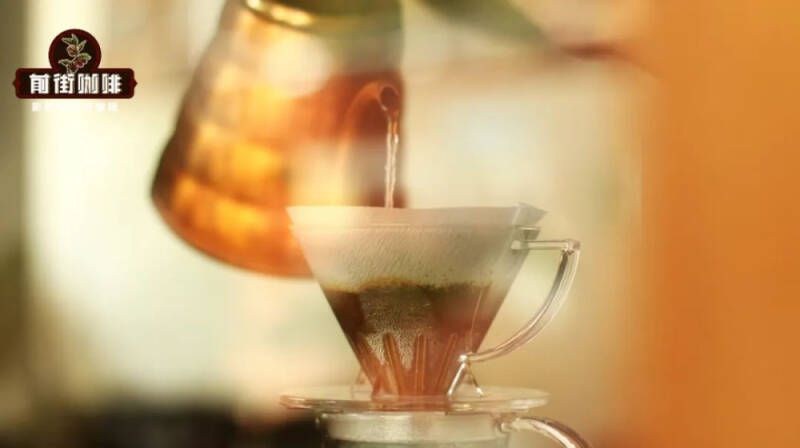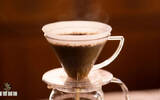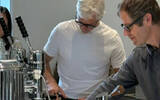Can boiling water be used to make coffee? What is the water temperature for hand flushing? Does it have to be 92°?
Once in the daily production process, a guest asked in front of the street: "Why does no one use 100 °C boiling water to make coffee?"

Water temperature, as a "tool" to adjust the extraction speed, is often the first parameter that many people pay attention to. Looking at all the coffee making tutorials, the water temperature is recommended to fall in the conservative range of 86-93 °C. very few people will extract coffee below 80 °C or higher than 95 °C. because we know that this can avoid coffee over-extraction and under-extraction from the water temperature.
So when you use boiled water to make coffee, what will it taste like in the end? True knowledge comes from practice, and we don't have much to say. Let's rush right away.

In this round of experiments, Qianjie was divided into two groups for comparative discussion. Under the premise that other parameters remained unchanged, the products were brewed at the corresponding normal temperature and boiling water, with a total of four pots of coffee. Here, Qianjie chooses two kinds of coffee beans with different roasting degrees to operate, one showing mellow bitterness of deep baked beans and one serving of shallow baked beans with sour fruit.
Coffee beans: Columbia dividing line large belly button (medium to shallow baking) powder quantity: 15g powder / water ratio: 1:15 Grinding degree: EK43s scale 9.5Grid filter Cup: Hario V60 Water injection technique: three-stage
93 °C group: TDS 1.27% / coffee measuring temperature 30 °C
The aroma of coffee from the conventional water temperature group is very full, not only with the refreshing taste of blackcurrant juice, but also with the delicate texture of blueberries and ripe Hawthorn, the aroma and flavor stay in the mouth for a long time, first sour then sweet, rich and memorable.
Boiling water group: TDS 1.53% / coffee measuring temperature 31.5 °C
Compared with the conventional water temperature group, using boiling water to brew the dividing line navel coffee, the entrance is passion fruit, black grape fruit aroma, orange-like acidity rising and domineering, but less ripe fruit fermentation flavor and spice flavor. Although not as rich as the previous group, the big belly button brewed with boiling water can also be called a cup of sour coffee.
Then, Qianjie chose a deep-roasted coffee bean for the second group of boiling water experiment.
Coffee beans: Indonesia Mantenin (medium and deep baking) powder quantity: 15g powder / water ratio: 1:15 Grinding degree: EK43s scale 10.5filter cup: KONO water injection technique: three-stage type
88 °C group: 1.38% coffee measured temperature 29.6 °C
The coffee shows the chocolate and nutty aroma of Manning, the entrance is as smooth as cream, accompanied by the sweetness of Pu'er tea, the taste is clear and mellow, and there is no negative taste even after the coffee is cooled.
Boiling water group: 1.56% coffee measuring temperature 32.8 °C
Because the water temperature is much higher than that of the first pot of routine group, the coffee smells slightly smoky, the entrance is bitter and miscellaneous, and the tongue is obviously astringent after swallowing, which reminds Qianjielian of an unripe green plum. After the coffee cooled, the whole cup of Mantenin was once reduced to "traditional Chinese medicine soup", and the smell of charred wood filled the whole mouth.
When we separate all the parameters of hand-brewed coffee, let's not talk about brewing techniques or flavor for a moment, but only discuss the effect of water temperature on the extraction rate of coffee. The obvious answer is that the higher the temperature, the faster the rate of dissolution of the substance, and the lower the temperature, the longer it takes to dissolve. This also explains that when we want to speed up the extraction efficiency of coffee, we usually increase the water temperature by 2 ~ 3 °C to obtain more flavor substances at the same time.
For shallow roasted coffee, it is composed of a variety of sour ingredients, the higher the temperature, the easier to release strong acid substances, so it is generally recommended to use 91 ~ 93 °C high temperature hot water.
With the deepening of the baking degree, various flavor substances in coffee gradually tend to caramel, and the substances that stay on the surface slowly move towards the characteristics of glycol, incense, smoking, richness, and so on, which is commonly known as "coffee flavor". The unpleasant taste will also increase at the end of the extraction. Therefore, in order to avoid the bitter rhyme of baking getting the upper hand, we are more accustomed to using lower temperature hot water for extraction, which usually falls in the range of 86 ~ 88 °C.
Through the above comparative experiments, we can see that no matter the deep roasted coffee is mellow or the shallow roasted coffee is mainly sour, the boiling water of 100 degrees is obviously not the ideal brewing temperature. After all, the boiling water parameter is at least 7 °C higher and the highest 14 °C higher than our usual reference water temperature, so the extraction efficiency of coffee will be much higher accordingly. In other words, it makes sour coffee easier and more sour, and bitter coffee easier and more bitter.
-END-
Important Notice :
前街咖啡 FrontStreet Coffee has moved to new addredd:
FrontStreet Coffee Address: 315,Donghua East Road,GuangZhou
Tel:020 38364473
- Prev

Lightning protection! Self-taught yourself the knowledge that you can easily be misled when making coffee by hand! What impact will the brewing method have on coffee?
Hand-brewed coffee is a unique and convenient way to make coffee. Because the coffee it makes has a distinctive flavor and clean taste, it has won the favor of a large number of people. Because of its easy operation and low investment threshold, many friends spontaneously learned to make hand-punching at home. However, due to the many learning channels, know
- Next

Worth the ticket price! The founder of Blue Bottle has gone to Shanghai to shake coffee!
▲ Click to pay attention| Daily Boutique Coffee Culture Magazine Coffee Workshop Today is the day when Blue Bottle studio Shanghai Station officially meets with the public. This unparalleled coffee omakase has naturally attracted the attention of coffee lovers. Before the official start of the event, Blue Bottle Coffee founder Jam
Related
- What effect does Italian American coffee with filter paper have? Will coffee taste better if it is put on filter paper at the bottom of the powder bowl?
- What is the color difference in coffee beans? What are the characteristics of honey processed coffee beans? Why are the anaerobically treated coffee beans uneven in color?
- How does novice Xiaobai quickly get started and make coffee? Newbies learn to make coffee by hand and share the specific steps and process process!
- Costa tea has a shelf life of 100 years?! Expert: Unable to verify
- It's a huge uproar! American milk addition was rejected by Manner employees?!
- Mocha pot coffee bean recommendations| How fine and how much powder should be used for grinding? What parameter ratios do I need to use to make milk with Mocha pot coffee?
- What are the characteristics of the world's top ten coffee beans treated with Costa Rica honey? How to make black honey kadura from Tarazhu Pilon Processing Plant taste good?
- How to make deep-roasted coffee? What grinding water temperature does authentic Jamaica Blue Mountain No. 1 coffee use to brew it well?
- Selected high-grade rose summer coffee flavor tasting guide Why Panama rose summer has the aroma of flowers and fruits
- What equipment does a novice Xiaobai need to buy to learn to make coffee? Filter cup electronic scale bean grinder manual flushing pot purchase guide

